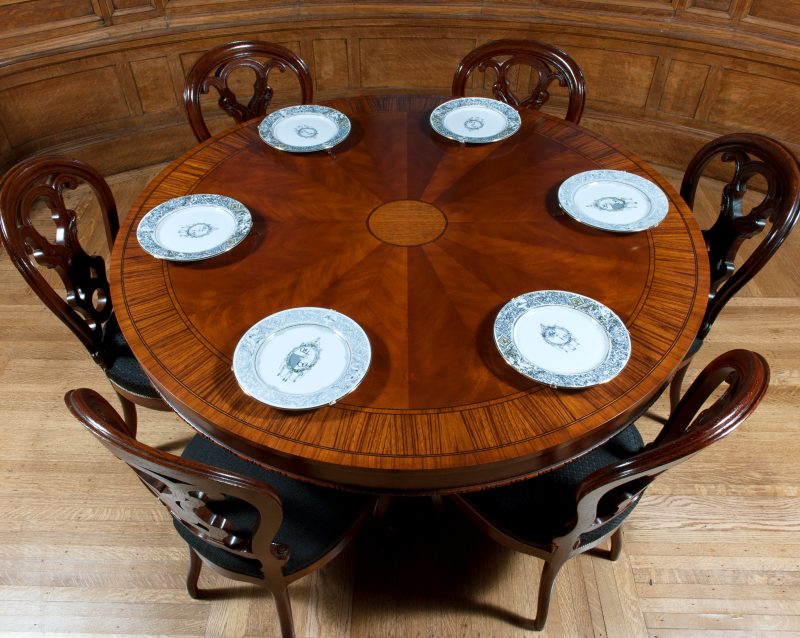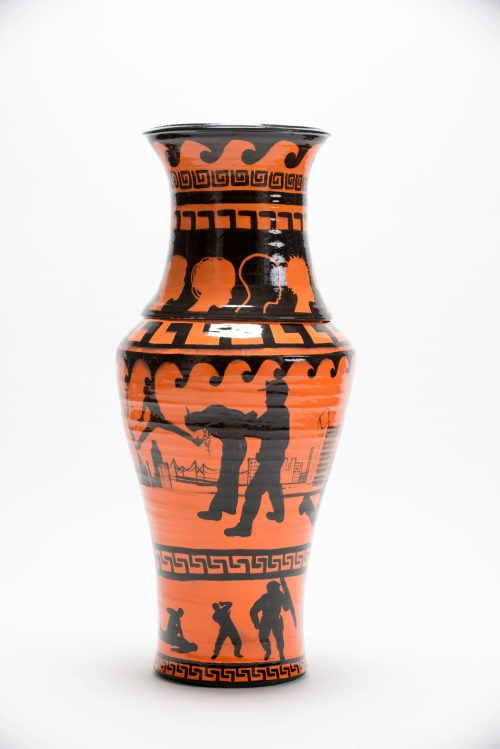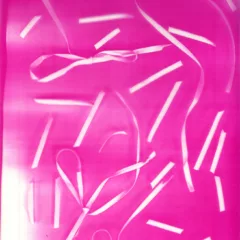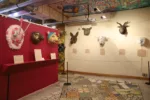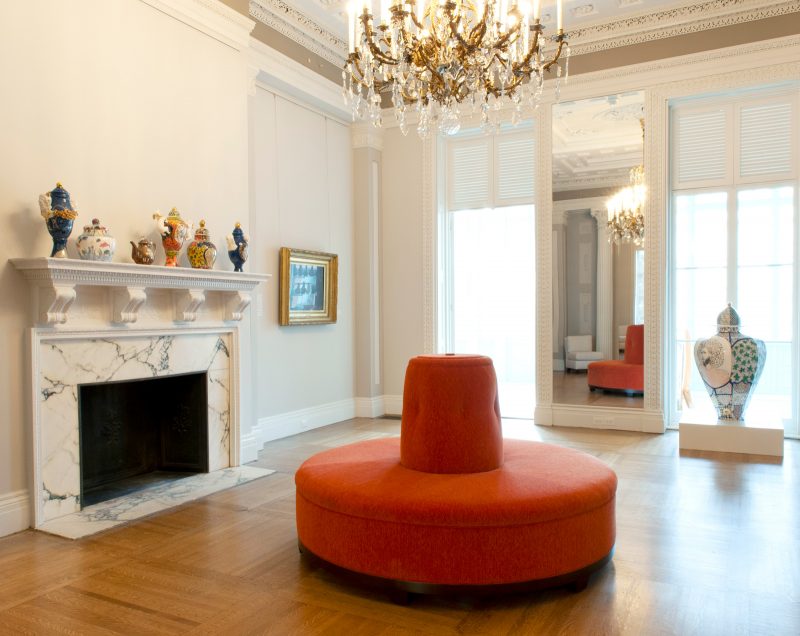
[EDITOR’S NOTE: we were recently informed that the show was not extended, and did in fact close on July 15th, as planned.]
For those of you who have not yet seen the installation, Roberto Lugo at 1 West, there is excellent news. The show has been extended until July 30th. Curated by Eleanor Hughes, Deputy Director of Art & Program, it is the first such installation in the newly renovated space, 1 West Mount Vernon Place, the museum’s 19th-century mansion, known by Baltimoreans as Hackerman House after its last private owner. The multi-level Italian Renaissance Revival period home, attached to the larger Renaissance palace-styled early 20th century museum, is now the setting for some of the Walter’s extensive ceramics collection.
Philadelphians know Lugo as a potter, educator, poet, public speaker and community activist who is Assistant Professor and Head of the Ceramics Program at Tyler School of Art, Temple University and who explores issues of race, poverty, obesity, and inequality in his work.
Indeed, three of Lugo’s topical works, “Frederick Douglass Food Stamp Jar,” “Six China Plates,” and “Slave Ship Potpourri Boat,” were added recently to the more traditional permanent Walters collection. Lugo comments upon the relationship between his work and that in the museum, “My work being alongside this incredible art is a dream come true because I feel like I’ve been able to make a bridge between museums and people who haven’t always been represented there.”*
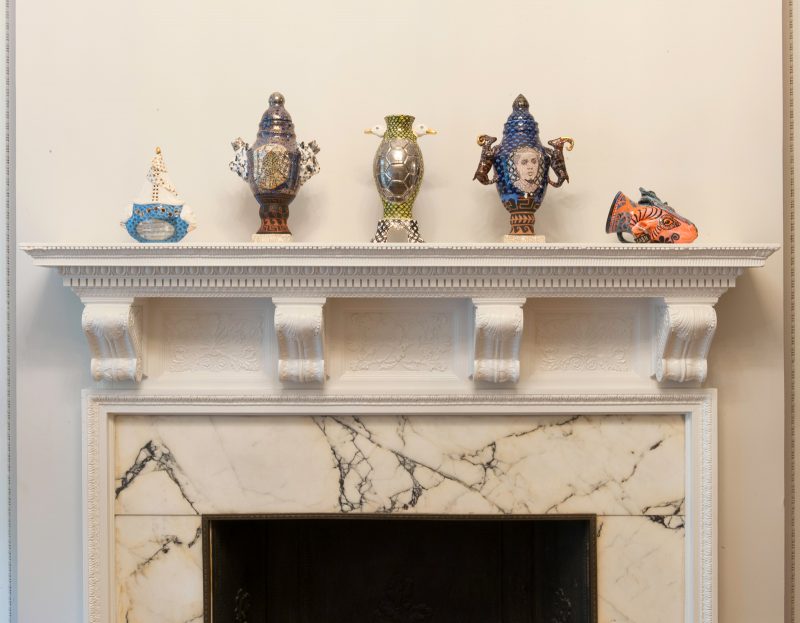
In the exhibition, Lugo’s vessels sit interspersed amongst the architectural details and the largely historical Asian and European ceramics. His contemporary pots rest on mantlepieces and tables and sit in niches, simultaneously complementing and contrasting with the elegant historic ceramics, graceful circular staircase, and oval Tiffany skylight. The vessels that sit on the mantels are not identical; they represent a “garniture” or groups of objects intended to be displayed together, common in grand houses of the period.
The large food stamp vessel references the brilliant 19th c. Maryland-born and raised former slave, author, and abolitionist, Frederick Douglass. The Walters provides an app (1 West) that incorporates the artist discussing his works in which he explains that the Douglass object is less about implicating or pointing fingers at the people who once lived in the house as it is an opportunity for an artist who grew up in Kensington to show his work in the elegant Hackerman House/The Walters Art Museum, and to offer a space for conversation rather than accusation.** Not only does the vessel include a portrait of Douglass with an Afro, but it also incorporates the names of all the people who taught Lugo how to create graffiti. Here, the artist links his personal history to Frederick Douglass, the first black man to be invited into the white house not as a servant, but as a guest. It sits in a niche just above a large early 20th century Japanese Arita ware jar and below a Tiffany skylight. Lugo’s vessel stands proud in this illustrious company.
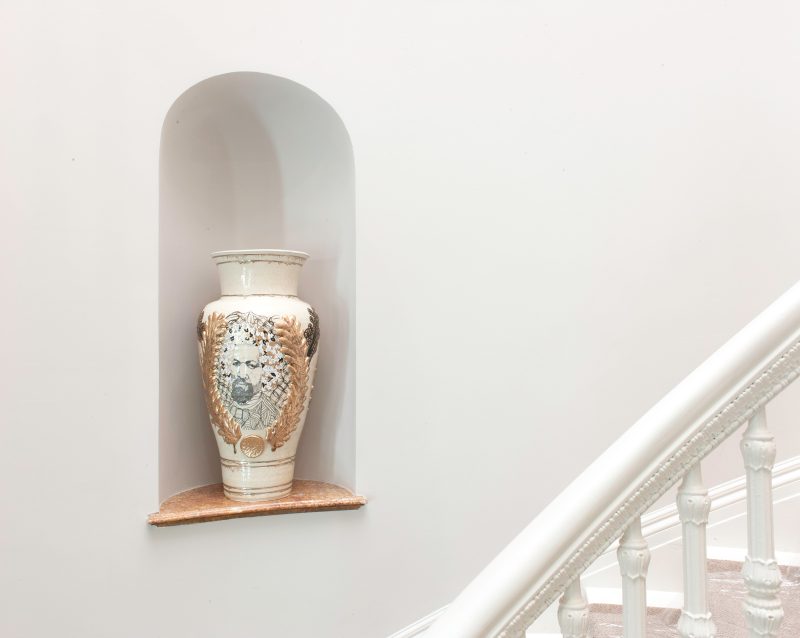
Lugo created a set of dinner plates especially for the Walters, inspired by a letter in the museum’s collection from Sybby Grant, an enslaved cook who worked at 1 West, to Dr. John Hanson Thomas, her master and a Maryland legislator who was incarcerated for his Confederate sympathies.*** From her letter, the artist learned that she had specialties, terrapin and canvasback duck, which he incorporated into the plate decorations, along with a monogram Lugo designer for her. He comments that he wanted to be careful about his decisions and to make something that would have pleased Grant, who likely never was served during her lifetime, and certainly not in the dining room of such a grand home.****
Lugo was inspired by objects from the museum’s collection, such as a Sevres Porcelain Potpourri Vase from 1764, installing a group of vessels together in a garniture that includes “Slave Ship Potpourri Boat.” Lugo’s boat takes the form of the earlier Sevres vessel, but now includes a double portrait of George Washington and an image based on an infamous diagram that depicts a vessel of 400 tightly-packed slaves. After doing research into his family history, the artist discovered that some of his family is Puerto Rican, indigenous Taíno, and African (the Congo).******
Many ideas emerge from this work: the establishment of democracy for white men, the relationship between the wealthy and the poor, and the history of the Transatlantic Slave Trade. Other vessels by Lugo in this grouping include portraits of women at well, for instance, Juanita Jackson, the first African American woman to practice law in Maryland.

Courtesy of the artist. Image by KeneK Photography courtesy of Wexler Gallery
An impressive large vessel in the show is “The Expulsion of Colin Kaepernick and John Brown.” In linking Kaepernick, who lost his football career by “taking a knee” during the playing of the national anthem, to the American Abolitionist and revolutionary John Brown, Lugo again brings together the past and the present. Inspired by the museum’s Greek pottery collection, the artist addresses the prison system in “Ghetto Krater,” seeing a relationship between the Greeks’ images of war and the difficult neighborhood of his childhood where many were killed, injured, or incarcerated.
In all of Lugo’s works, and there are many more in this exhibition than those discussed, the artist demonstrates a combination of exquisite technique and significant content. Lugo is a master craftsman who addresses important topics through the decorative arts; the Walters Art Museum offers a perfect setting to showcase his work.
Roberto Lugo at 1 West, until July 30, 2019. The Walters Art Museum, 600 N. Charles St. Baltimore, MD, 410-547-9000 Hours: Wednesday–Sunday: 10 a.m.–5 p.m. Thursday: 10 a.m.–9 p.m. Monday–Tuesday: Closed
Admission to 1 West Mount Vernon Place and the Walters Art Museum is free.
FOOTNOTES
* “Press Release for ‘Robert Lugo 1 West.’”
** Robert Lugo in conversation” 1 West app.
*** Letter of Sybby Grant to Dr. John Hanson Thomas, December 6, 1861. Collection of the Walters Art Museum.
****Roberto Lugo in conversation, 1 West app.
*****The Brooks Slave Ship Drawing,“ A History of the World, The British Museum
This now well-known diagram was first created and published by William Elford and the Plymouth chapter of the Society for Effecting the Abolition of the Slave Trade in 1788.
******Cara Ober, “Criticality and Ceramics at the Walters, “ BMoreArt, July 2, 2018
More Photos
